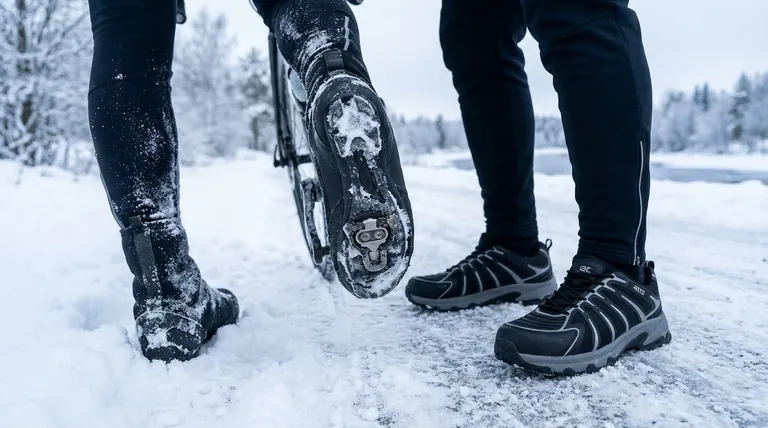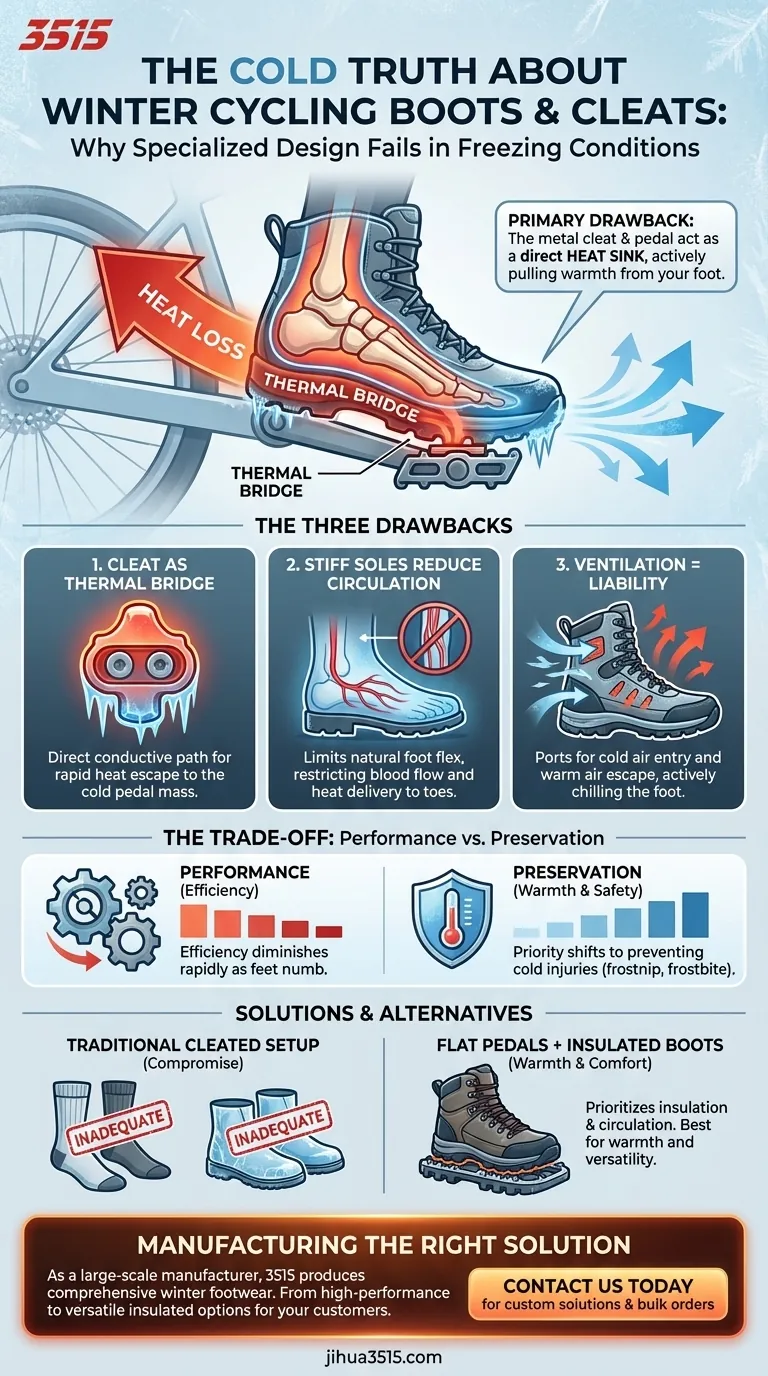The primary drawback of using bike-specific boots with cleats in cold weather is that the metal cleat and pedal system acts as a direct heat sink, actively pulling warmth away from your foot and making you significantly colder. This thermal bridge negates many of the benefits of the boot's insulation.
The core issue is a conflict of design. Standard cycling shoes are engineered for power transfer and ventilation, making them fundamentally unsuited for cold protection. The very components that enhance performance in warm weather become liabilities when temperatures drop.

The Core Problem: A Design Mismatch
Cycling footwear is a specialized tool. Unfortunately, its specialization is for warm, dry conditions, where heat dissipation and rigidity are benefits. In the cold, these features work directly against your comfort and safety.
The Cleat as a Thermal Bridge
The metal cleat bolted to your shoe creates a direct, highly conductive pathway to the large metal mass of your pedal. This phenomenon, known as a thermal bridge, allows heat to escape from the sole of your foot at an accelerated rate.
Your body simply cannot generate heat fast enough to overcome this constant drain, leading to numb, painful toes even in well-insulated boots.
Stiff Soles Reduce Circulation
The extreme stiffness of a cycling shoe sole is excellent for transferring power to the pedals. However, it severely restricts the natural flex and movement of your foot.
This lack of movement reduces blood circulation, which is critical for keeping your extremities warm. Less blood flow means less heat delivered to your toes.
Ventilation Becomes a Liability
Most cycling shoes, even many winter models, incorporate some form of ventilation to manage sweat and heat in the summer.
In the winter, these vents become ports for icy air to enter and warm air to escape, actively chilling your foot with every pedal stroke.
Understanding the Trade-offs
Choosing to ride with cleats in the cold means accepting a significant compromise between pedaling efficiency and personal safety and comfort.
Performance vs. Preservation
While cleats offer superior pedaling efficiency, this benefit diminishes rapidly as your feet become numb and painful. Cold reduces muscle function and can make you clumsy.
In freezing conditions, the priority shifts from peak performance to preventing cold-related injuries like frostnip or frostbite.
The Inadequacy of Standard Solutions
Simple solutions like thicker socks or neoprene shoe covers can help, but they are often fighting a losing battle against the fundamental design flaws.
Shoe covers can block wind but do little to stop the heat loss through the cleat. Thick socks can help insulate, but they can also make shoes too tight, further restricting blood flow and negating their own benefit.
Making the Right Choice for Your Goal
To stay warm, you must address the core issues of thermal bridging and poor insulation. This often means abandoning the traditional cleated setup.
- If your primary focus is performance on short, intense rides: A dedicated, high-end winter cycling boot paired with thermal shoe covers may be sufficient, but you must remain vigilant for signs of cold feet.
- If your primary focus is warmth and comfort: Switching to flat pedals and a quality pair of insulated, waterproof winter hiking boots is the most effective solution.
- If your primary focus is safety and versatility: Flat pedals with standard winter boots provide the best combination of on-bike warmth and secure off-bike traction on icy or snowy surfaces.
Ultimately, protecting your feet from the cold requires prioritizing insulation and circulation over pure pedaling efficiency.
Summary Table:
| Drawback | Impact |
|---|---|
| Cleat as Thermal Bridge | Metal cleat pulls heat from foot, causing rapid heat loss. |
| Stiff Soles | Restricts foot movement and blood circulation, reducing warmth. |
| Built-in Ventilation | Allows cold air in and warm air out, actively chilling feet. |
Don't let cold feet derail your winter riding plans. As a large-scale manufacturer, 3515 produces a comprehensive range of footwear for distributors, brand owners, and bulk clients. Whether you need high-performance winter cycling boots or versatile insulated boots for flat pedals, our production capabilities encompass all types of shoes and boots designed for safety and comfort in harsh conditions. Contact us today to discuss how we can provide the right winter footwear solution for your customers.
Visual Guide

Related Products
- Premium KPU Athletic Safety Shoes for Wholesale
- Durable Rubber-Soled Utility Shoes for Wholesale & Custom Brand Manufacturing
- Wholesale Training Shoes with Dial Lacing System Custom OEM Manufacturing
- Wholesale Breathable Training Shoes Custom Athletic Footwear Manufacturer
- Wholesale Durable & Breathable Training Shoes for Custom Brands
People Also Ask
- Why is expert help recommended when selecting safety shoes? Ensure Perfect Fit & Hazard Protection
- What does a green triangle symbol on safety footwear mean? Your Guide to Maximum Puncture & Impact Protection
- How is puncture resistance evaluated in footwear soles? Balance Protection, Comfort & Safety
- What types of workplace hazards require protective footwear? Essential Guide for Workplace Safety
- What are the conditions faced by employees in meatpacking and poultry slaughter plants? Navigating Pervasive Slip Hazards



















